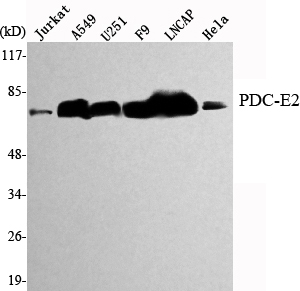PDC-E2 Monoclonal Antibody
- Catalog No.:YM1071
- Applications:WB
- Reactivity:Human;Rabbit
- Target:
- PDC-E2
- Fields:
- >>Glycolysis / Gluconeogenesis;>>Citrate cycle (TCA cycle);>>Pyruvate metabolism;>>Metabolic pathways;>>Carbon metabolism
- Gene Name:
- DLAT
- Protein Name:
- Dihydrolipoyllysine-residue acetyltransferase component of pyruvate dehydrogenase complex mitochondrial
- Human Gene Id:
- 1737
- Human Swiss Prot No:
- P10515
- Mouse Swiss Prot No:
- Q8BMF4
- Rat Swiss Prot No:
- P08461
- Immunogen:
- Purified recombinant human PDC-E2 protein fragments expressed in E.coli.
- Specificity:
- PDC-E2 Monoclonal Antibody detects endogenous levels of PDC-E2 protein.
- Formulation:
- Liquid in PBS containing 50% glycerol, 0.5% BSA and 0.02% sodium azide.
- Source:
- Monoclonal, Mouse
- Dilution:
- WB 1:1000 - 1:2000. Not yet tested in other applications.
- Purification:
- Affinity purification
- Concentration:
- 1 mg/ml
- Storage Stability:
- -15°C to -25°C/1 year(Do not lower than -25°C)
- Other Name:
- DLAT;DLTA;Dihydrolipoyllysine-residue acetyltransferase component of pyruvate dehydrogenase complex; mitochondrial;70 kDa mitochondrial autoantigen of primary biliary cirrhosis;PBC;Dihydrolipoamide acetyltransferase component of pyruva
- Molecular Weight(Da):
- 69kD
- Background:
- This gene encodes component E2 of the multi-enzyme pyruvate dehydrogenase complex (PDC). PDC resides in the inner mitochondrial membrane and catalyzes the conversion of pyruvate to acetyl coenzyme A. The protein product of this gene, dihydrolipoamide acetyltransferase, accepts acetyl groups formed by the oxidative decarboxylation of pyruvate and transfers them to coenzyme A. Dihydrolipoamide acetyltransferase is the antigen for antimitochondrial antibodies. These autoantibodies are present in nearly 95% of patients with the autoimmune liver disease primary biliary cirrhosis (PBC). In PBC, activated T lymphocytes attack and destroy epithelial cells in the bile duct where this protein is abnormally distributed and overexpressed. PBC enventually leads to cirrhosis and liver failure. Mutations in this gene are also a cause of pyruvate dehydrogenase E2 deficiency which causes primary lact
- Function:
- catalytic activity:Acetyl-CoA + enzyme N(6)-(dihydrolipoyl)lysine = CoA + enzyme N(6)-(S-acetyldihydrolipoyl)lysine.,cofactor:Binds 2 lipoyl cofactors covalently.,disease:Defects in DLAT are the cause of pyruvate dehydrogenase E2 deficiency [MIM:245348]; also known as lactic acidemia due to defect of E2 lipoyl transacetylase of the pyruvate dehydrogenase complex. Pyruvate dehydrogenase (PDH) deficiency is a major cause of primary lactic acidosis and neurological dysfunction in infancy and early childhood. In this form of PDH deficiency episodic dystonia is the major neurological manifestation, with other more common features of pyruvate dehydrogenase deficiency, such as hypotonia and ataxia, being less prominent.,disease:Primary biliary cirrhosis is a chronic, progressive cholestatic liver disease characterized by the presence of antimitochondrial autoantibodies in patients' serum. It ma
- Subcellular Location:
- Mitochondrion matrix.
- Expression:
- Heart,Keratinocyte carcinoma,Kidney,Liver,Placenta,Testis,
- June 19-2018
- WESTERN IMMUNOBLOTTING PROTOCOL
- June 19-2018
- IMMUNOHISTOCHEMISTRY-PARAFFIN PROTOCOL
- June 19-2018
- IMMUNOFLUORESCENCE PROTOCOL
- September 08-2020
- FLOW-CYTOMEYRT-PROTOCOL
- May 20-2022
- Cell-Based ELISA│解您多样本WB检测之困扰
- July 13-2018
- CELL-BASED-ELISA-PROTOCOL-FOR-ACETYL-PROTEIN
- July 13-2018
- CELL-BASED-ELISA-PROTOCOL-FOR-PHOSPHO-PROTEIN
- July 13-2018
- Antibody-FAQs
- Products Images

- Western Blot analysis using PDC-E2 Monoclonal Antibody against Jurkat, A549, U251, F9, LNCAP, HeLa cell lysate.



